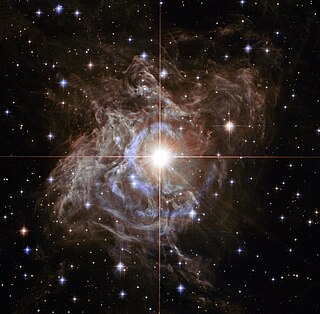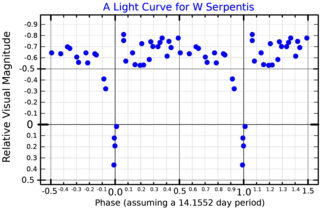
In astronomy, a semiregular variable star, a type of variable star, is a giant or supergiant of intermediate and late (cooler) spectral type showing considerable periodicity in its light changes, accompanied or sometimes interrupted by various irregularities. Periods lie in the range from 20 to more than 2000 days, while the shapes of the light curves may be rather different and variable with each cycle. The amplitudes may be from several hundredths to several magnitudes.

A Cepheid variable is a type of star that pulsates radially, varying in both diameter and temperature and producing changes in brightness with a well-defined stable period and amplitude.

The descriptive term long-period variable star refers to various groups of cool luminous pulsating variable stars. It is frequently abbreviated to LPV.

A Delta Scuti variable is a subclass of young pulsating star. These variables as well as classical cepheids are important standard candles and have been used to establish the distance to the Large Magellanic Cloud, globular clusters, open clusters, and the Galactic Center. The variables follow a period-luminosity relation in certain passbands like other standard candles such as Cepheids. SX Phoenicis variables are generally considered to be a subclass of Delta Scuti variables that contain old stars, and can be found in globular clusters. SX Phe variables also follow a period-luminosity relation. One last sub-class are the pre-main sequence (PMS) Delta Scuti variables.

NGC 663 is a young open cluster in the constellation of Cassiopeia. It has an estimated 400 stars and spans about a quarter of a degree across the sky. It can reportedly be detected with the unaided eye, although a telescope is recommended for best viewing. The brightest members of the cluster can be viewed with binoculars. Although the listed visual magnitude is 7.1, several observers have reported higher estimates.

The Optical Gravitational Lensing Experiment (OGLE) is a Polish astronomical project based at the University of Warsaw that runs a long-term variability sky survey (1992–present). The main goals are the detection and classification of variable stars, discovery of microlensing events, dwarf novae, and studies of the structure of the Galaxy and the Magellanic Clouds. Since the project began in 1992, it has discovered a multitude of extrasolar planets, together with the first planet discovered using the transit method (OGLE-TR-56b) and gravitational microlensing. The project has been led by professor Andrzej Udalski since its inception.

W Mensae is an unusual yellow supergiant star in the Large Magellanic Cloud in the southern constellation Mensa. It is an R Coronae Borealis variable and periodically decreases in brightness by several magnitudes.
A Lambda Eridani Variable is a class of Be stars that show small amplitude variations of a few hundredths of a magnitude. The variations are highly regular with periods between 0.5 and 2.0 days, and they were initially described as periodic Be stars. Lambda Eridani is an example and the prototype. This has been ascribed to non-radial pulsations, inhomogeneous rotating discs, or the rotation of the star itself.
OGLE-TR-113 is a dim, distant magnitude 16 binary star in the star fields of the constellation Carina. Because of its distance of about 1170 light years, and location in a crowded field it was not notable in any way. Its apparent brightness changes when one of its planets transits, so the star has been given the variable star designation V752 Carinae. Spectral type of the star is type K dwarf star, slightly cooler and less luminous than the Sun.

WOH G64 is an unusual red supergiant (RSG) star in the Large Magellanic Cloud (LMC) satellite galaxy in the southern constellation of Dorado. It is one of the largest known stars, being described as possibly being the largest star known. It is also one of the most luminous and massive red supergiants, with a radius calculated to be around 1,540 times that of the Sun (R☉) and a luminosity around 282,000 times the solar luminosity (L☉).

Type II Cepheids are variable stars which pulsate with periods typically between 1 and 50 days. They are population II stars: old, typically metal-poor, low mass objects.

Classical Cepheids are a type of Cepheid variable star. They are population I variable stars that exhibit regular radial pulsations with periods of a few days to a few weeks and visual amplitudes from a few tenths of a magnitude to about 2 magnitudes.

BL Herculis variables are a subclass of type II Cepheids with low luminosity and mass, that have a period of less than eight days. They are pulsating stars with light curves that frequently show a bump on the descending side for stars of the shortest periods and on the ascending side for longer period stars. Like other type II Cepheids, they are very old population II stars found in the galaxy’s halo and globular clusters. Also, compared to other type II Cepheids, BL Herculis variables have shorter periods and are fainter than W Virginis variables. Pulsating stars vary in spectral class as they vary in brightness and BL Herculis variables are normally class A at their brightest and class F when most dim. When plotted on the Hertzsprung–Russell diagram they fall in-between W Virginis and RR Lyrae variables.

W Serpentis is an eclipsing binary star in the constellation Serpens. It is always too faint to be seen with the naked eye, varying between apparent magnitudes 8.42 and 10.2 with a period of just over 14 days. This is mainly due to eclipses; however, variations in its period indicate there are some innate changes in luminosity of one or both component stars as they interact with each other, and it has been difficult to disentangle the light to determine their nature. The period is increasing by 14 seconds a year, indicating that a massive amount of material is being transferred from the larger fainter star to the smaller brighter one.

OGLE-LMC-CEP0227 is an eclipsing binary and Cepheid variable star, pulsating every 3.8 days. The star, in the Large Magellanic Cloud, was the first Cepheid star system found to be orbiting exactly edge on.

TU Mensae is a cataclysmic variable star of in the constellation Mensa. A close binary, it consists of a white dwarf and low-mass star orbiting each other in 2 hours 49 minutes. The stars are close enough that the white dwarf strips material off the other star, creating an accretion disc that periodically ignites with a resulting brightening of the system. These result in an increase in brightness lasting around a day every 37 days. Brighter outbursts, known as superhumps, last 5-20 days and take place every 194 days. The properties of TU Mensae have been difficult to calculate, as the calculated mass ratio between the two stars mean there should not be superhumps.

XY Ursae Majoris is a short period binary star system in the northern circumpolar constellation of Ursa Major. It is an eclipsing binary with a baseline apparent visual magnitude of 9.50. The system is located at a distance of 221.5 light years from the Sun based on parallax measurements, but is drifting closer with a radial velocity of −10 km/s. It has a relatively high proper motion, traversing the celestial sphere at the angular rate of 0.191″·yr−1.

AG Virginis is an eclipsing binary star system in the equatorial constellation of Virgo. With a maximum apparent visual magnitude of 8.51 it is too faint to be visible to the naked eye. The system is located at a distance of approximately 820 light years from the Sun based on parallax measurements.

ER Vulpeculae is a binary star system in the northern constellation of Vulpecula, abbreviated ER Vul. It is a variable star system with a brightness that ranges from an apparent visual magnitude of 7.27 down to 7.49, which is too faint to be visible to the naked eye. This system is located at a distance of 165 light years from the Sun based on parallax measurements. It is drifting closer with a radial velocity of −25 km/s.















